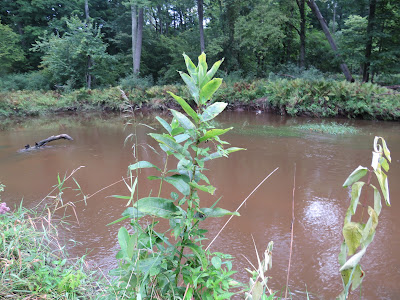Morning hazy sunlight and temperatures in the mid 60’s greet me on my final encounter with Salt Creek. Hoping to find its confluence with the Chippewa River, I follow a two-track north where I watch Bumblebees feed on Purples Loosestrife blossoms and then stop, pick and eat a few ripe Blackberries. Stepping off the path into dense underbrush, I spot blossoms of Jerusalem Artichoke and then pause to observe an Allegheny mound ant moving around its 18 inch diameter by 12-inch high mound. The mound acts as a solar collector for incubating ant eggs and larvae. This insect has many queens to lay eggs as opposed to other ants that may have only one. A mound like this contains thousands of individuals. After slogging another 100 yards through muddy, uneven terrain, I arrive at the creek’s edge where I notice several blossoms of Joe-Pye weed. Exploring a patch of Milkweed, I come upon a perching Northern Paper wasp and a two-inch lifeless, Monarch caterpillar. The dark color of the caterpillar is a symptom of “Black Death”, a term used to describe the effects of two different fatal infections, a Pseudomonas bacteria and a Nuclear polyhedrosis virus. Scanning the water, I get a quick glimpse of a 12-inch Northern Map turtle, before it submerges. This reptile gets its name from the markings on its carapace, which resemble contour lines on a map. However, the carapace markings tend to fade as the animal matures, and in older individuals are usually only visible when the shell is wet. Overhead, I notice a Witch Hazel tree displaying lots of greenish seed capsules. These capsules will turn light brown and become woody with age. Each capsule splits open in fall of the following year, ejecting their black seeds up to 30 feet. Nearby, I see a Basswood tree displaying green nutlets along with bracts- modified leaves that aid in the wind dispersal of the seeds. Most nutlets are eaten in the fall by chipmunks, mice, squirrels, porcupines and rabbits. With no trail in sight, I follow the stream toward its end (stock photo), one mile to the east. After a short, challenging trek through a wet floodplain, I realize I cannot make it, so I stop, take one last look at Salt Creek and bid a fond farewell to this wonderful watercourse. Nearing the car, I pause to hear the distinctive song of a Veery. This small thrush (stock photo) gets its name from the cascade of “veer” notes that make up its song. These rarely-seen birds hop through the forest understory as they forage for insects and fruit. They spend winters in South America.
Birds begin morning tunes
My walk in the early day
Meandering in a meadow
Mother Nature shows the way
Trail that’s mine alone
Path before me leads on
Over hill, past a swale
From woods to placid pond
Beside a tree, across a ditch
Field where butterflies soar
I continue to hike along
Much more to explore
D. DeGraaf



